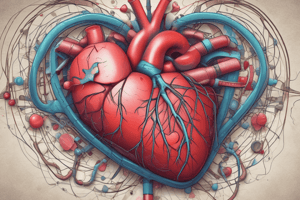Podcast
Questions and Answers
Class I anti-arrhythmic drugs, specifically Class IA, bring about decreased conduction velocity by increasing inward Na+ current.
Class I anti-arrhythmic drugs, specifically Class IA, bring about decreased conduction velocity by increasing inward Na+ current.
False (B)
Class IB anti-arrhythmic drugs, such as Lidocaine and Phenytoin, bring about little change in conductivity by increasing the outward K+ current.
Class IB anti-arrhythmic drugs, such as Lidocaine and Phenytoin, bring about little change in conductivity by increasing the outward K+ current.
True (A)
Class IC anti-arrhythmic drugs, Encanide and Lorcainide, significantly decrease action potential duration without affecting conductivity.
Class IC anti-arrhythmic drugs, Encanide and Lorcainide, significantly decrease action potential duration without affecting conductivity.
False (B)
Class III anti-arrhythmic drugs primarily lengthen action potential duration and refractory period in the SA node and atrial muscle.
Class III anti-arrhythmic drugs primarily lengthen action potential duration and refractory period in the SA node and atrial muscle.
Class II beta-adrenergic blockers exert their antiarrhythmic effects by blocking alpha-adrenergic receptors.
Class II beta-adrenergic blockers exert their antiarrhythmic effects by blocking alpha-adrenergic receptors.
Class IV calcium entry blockers effectively suppress ventricular rate in atrial flutter and fibrillation by blocking sodium entry into myocardial cells.
Class IV calcium entry blockers effectively suppress ventricular rate in atrial flutter and fibrillation by blocking sodium entry into myocardial cells.
Catecholamines decrease heart rate and contractility especially at high doses.
Catecholamines decrease heart rate and contractility especially at high doses.
Arrhythmias are always pathological and require immediate treatment.
Arrhythmias are always pathological and require immediate treatment.
Potassium depletion is not a factor that increases sensitivity to digitalis.
Potassium depletion is not a factor that increases sensitivity to digitalis.
Stopping medication is usually not the way to reverse digitalis toxicity.
Stopping medication is usually not the way to reverse digitalis toxicity.
Vitamin K antagonists such as Warfarin are toxic in humans.
Vitamin K antagonists such as Warfarin are toxic in humans.
Protamine sulfate is a systemic anticoagulant used to prevent and treat venous thrombosis.
Protamine sulfate is a systemic anticoagulant used to prevent and treat venous thrombosis.
Sympathomimetic agents stimulate cardiac α1-adrenergic receptors, leading to decreased calcium influx.
Sympathomimetic agents stimulate cardiac α1-adrenergic receptors, leading to decreased calcium influx.
Thrombin is a type of antiarrhythmic drug used for myocardial failure.
Thrombin is a type of antiarrhythmic drug used for myocardial failure.
Thrombin acts by combining and enhancing the action of antithrombin V.
Thrombin acts by combining and enhancing the action of antithrombin V.
Epinephrine and Norepinephrine cause hemostasis by vasodilation.
Epinephrine and Norepinephrine cause hemostasis by vasodilation.
Sodium Citrate is a systemic anticoagulant used in blood transfusion.
Sodium Citrate is a systemic anticoagulant used in blood transfusion.
Heparin is present in mast cells along with histamine and serotonin.
Heparin is present in mast cells along with histamine and serotonin.
Flashcards are hidden until you start studying




